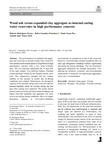Mostrar o rexistro simple do ítem
Wood Ash Versus Expanded Clay Aggregate as Internal Curing Water Reservoirs in High Performance Concrete
| dc.contributor.author | Rodríguez-Álvaro, Roberto | |
| dc.contributor.author | González-Fonteboa, Belén | |
| dc.contributor.author | Seara Paz, Sindy | |
| dc.contributor.author | Tenza-Abril, Antonio José | |
| dc.date.accessioned | 2022-06-21T17:11:32Z | |
| dc.date.available | 2022-06-21T17:11:32Z | |
| dc.date.issued | 2022 | |
| dc.identifier.citation | Rodríguez-Álvaro, R., González-Fonteboa, B., Seara-Paz, S. et al. Wood ash versus expanded clay aggregate as internal curing water reservoirs in high performance concrete. Mater Struct 55, 118 (2022). https://doi.org/10.1617/s11527-022-01963-3 | es_ES |
| dc.identifier.uri | http://hdl.handle.net/2183/30970 | |
| dc.description | Financiado para publicación en acceso aberto: Universidade da Coruña/CISUG | es_ES |
| dc.description.abstract | [Abstract] The performances of expanded clay aggregate and wood ash as internal curing water reservoirs were studied in the mortar phase of a hypothetical high performance concrete with a low water-to-binder ratio. The two materials substituted the 15 and 30% of the sand volume. Two different binders, Portland cement and high-volume fly ash blended cement, were used. The compressive strength and the volume stability of the mortars in sealed and air-drying conditions were studied. Furthermore, the desorption capacity of the internal curing water reservoirs and the internal humidity inside the mortars during the first days after casting were analysed. The results shown that the reduction in the self-desiccation shrinkage was higher when the expanded clay aggregate was used, even in air-drying curing conditions, due to its higher desorption capacity in low-relative-humidity environments in comparison to that of the wood ash. However, wood ash had a stronger beneficial effect on early age autogenous shrinkage without significantly increasing the drying shrinkage. The two alternative aggregates influenced the strength moderately. Considering the technical, economic, and environmental implications of using the two lightweight aggregates, wood ash is recommended. | es_ES |
| dc.description.sponsorship | Funding for open access charge: Universidade da Coruña/CISUG. This work has been carried out within the framework of the HACCURACEM project (BIA2017-85657-R), funded by the Ministry of Economy, Industry and Competitiveness, State Program for Research, Development and Innovation aimed at the challenges of Society, within the framework of the State Plan for Scientific and Technical Research and Innovation 2013–2016, Call 2017. We also thank the Xunta de Galicia (Spain) for the financial support through its pre-doctoral contracts program. Finally, we highlight the collaboration of the companies Votorantim Cimentos and Grupo BASF, for the contribution of some of the materials used in this research | es_ES |
| dc.language.iso | eng | es_ES |
| dc.publisher | Springer | es_ES |
| dc.relation | info:eu-repo/grantAgreement/AEI/Plan Estatal de Investigación Científica y Técnica y de Innovación 2013-2016/BIA2017-85657-R/ES/HORMIGONES SOSTENIBLES AUTOCOMPACTANTES DE ALTAS PRESTACIONES MEDIANTE EL USO DE CEMENTOS DE BAJO CONTENIDO EN CLINKER Y AGENTES DE CURADO INTERNO Y AUTSELLADO/ | |
| dc.relation.uri | https://doi.org/10.1617/s11527-022-01963-3 | es_ES |
| dc.rights | Atribución 4.0 Internacional | es_ES |
| dc.rights.uri | http://creativecommons.org/licenses/by/4.0/ | * |
| dc.subject | Internal curing agent | es_ES |
| dc.subject | Curing sensitivity | es_ES |
| dc.subject | Residues | es_ES |
| dc.subject | By-product | es_ES |
| dc.subject | Circular economy | es_ES |
| dc.title | Wood Ash Versus Expanded Clay Aggregate as Internal Curing Water Reservoirs in High Performance Concrete | es_ES |
| dc.type | info:eu-repo/semantics/article | es_ES |
| dc.rights.access | info:eu-repo/semantics/openAccess | es_ES |
| UDC.journalTitle | Materials and Structures | es_ES |
| UDC.volume | 55 | es_ES |
| UDC.startPage | 118 | es_ES |
| dc.identifier.doi | 10.1617/s11527-022-01963-3 |






